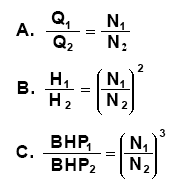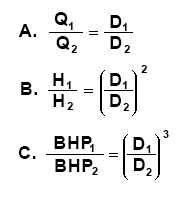Affinity Laws
The affinity laws express the mathematical relationship between the several variables involved in pump performance. They apply to all types of centrifugal and axial flow pumps. They are as follows:
1. With impeller diameter, D, held constant:

- Q = Capacity, GPM
- H = Total Head, Feet
- BHP = Brake Horsepower
- N = Pump Speed, RPM
2. With speed, N, held constant:

When the performance (Q1, H1, & BHP1) is known at some particular speed (N1) or diameter (D1), the formulas can be used to estimate the performance (Q2, H2, & BHP2) at some other speed (N2) or diameter (D2). The efficiency remains nearly constant for speed changes and for small changes in impeller diamater.
You may occasionally need to estimate the hydraulic performance of a centrifugal pump at a speed or impeller diameter not shown on the catalog performance curves. To approximate the performance of the pump, the affinity laws should be used as follows:
The pump capacity, or flow rate, "Q" varies with the ratio of RPM:
Q2 = Q1 x N2/N1
The pump head "H" varies with the ratio of RPM2:
H2 = H1 x (N2/N1)2
The pump brake horsepower "BHP" varies with the ratio of RPM3:
BHP2 = BHP1 x (N2/N1)3
EXAMPLE: A customer has an application where he prefers to use a v-belt drive with a maximum diameter impeller, instead of operating at a standard motor speed and trimming the impeller diameter. You have a catalog curve giving the operating characteristics of the pump at 1750 RPM. You want to determine the pump curve at 1535 RPM. The calculations are as follows:
1535/1750 = 0.8771
(1535/1750)2 = 0.7694
(1535/1750)3 = 0.6749
Data from 1750 RPM Curve
| Q(GPM) | H(Ft.) | BHP | Eff. |
|---|---|---|---|
| 0 | 150 | 9.0 | 0% |
| 100 | 135 | 9.7 | 35% |
| 200 | 120 | 11.0 | 55% |
| 300 | 105 | 12.1 | 66% |
| 400 | 80 | 15.2 | 53% |
Calculated data for 1535 RPM
| Q x 0.8771 | H x 0.7694 | BHP x 0.6749 |
|---|---|---|
| Q(GPM) | H (Ft.) | BHP |
| 0 | 115 | 6.1 |
| 88 | 104 | 6.5 |
| 175 | 92 | 7.4 |
| 263 | 81 | 8.2 |
| 351 | 62 | 10.3 |
The affinity laws can also be applied to impeller diameter variations. Example: Same pump @ 1750 RPM, but now you want to see the effects of trimming the impeller diameter from 13" to 12.25".